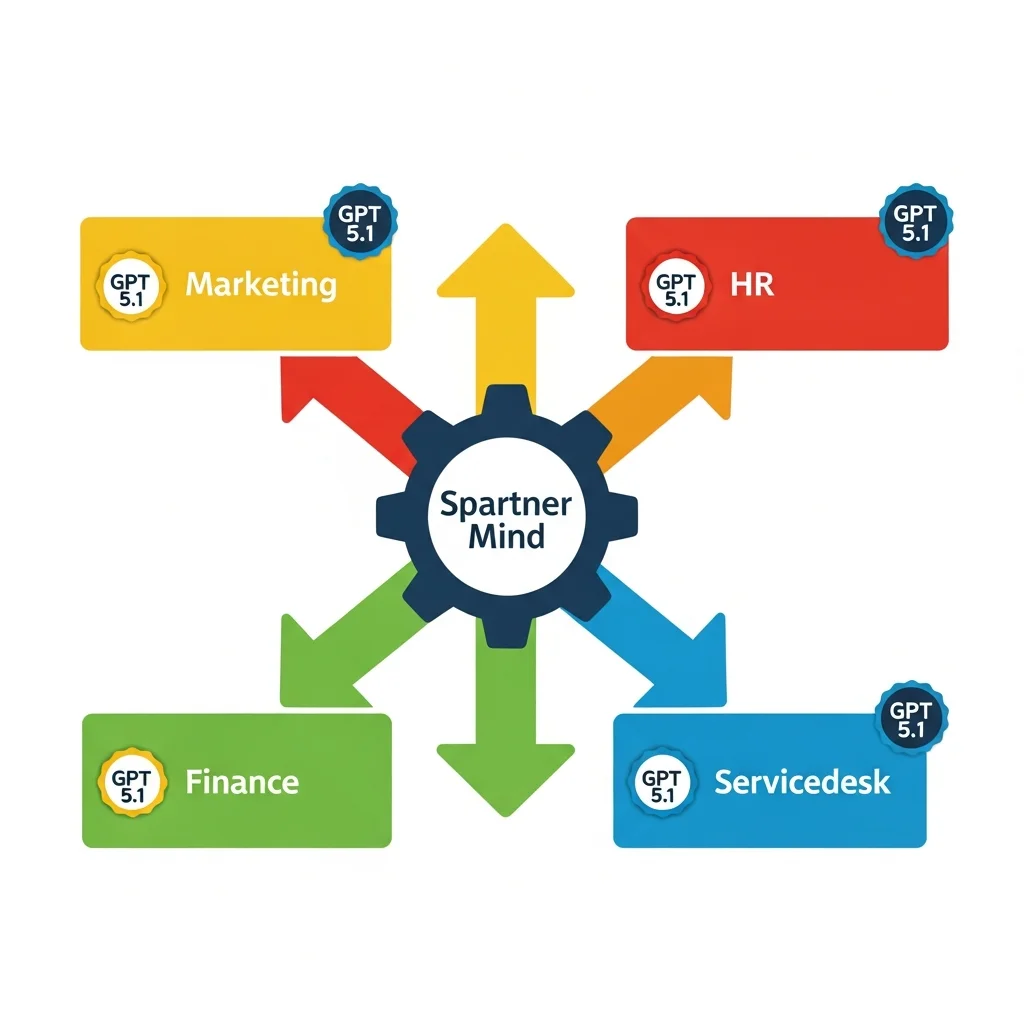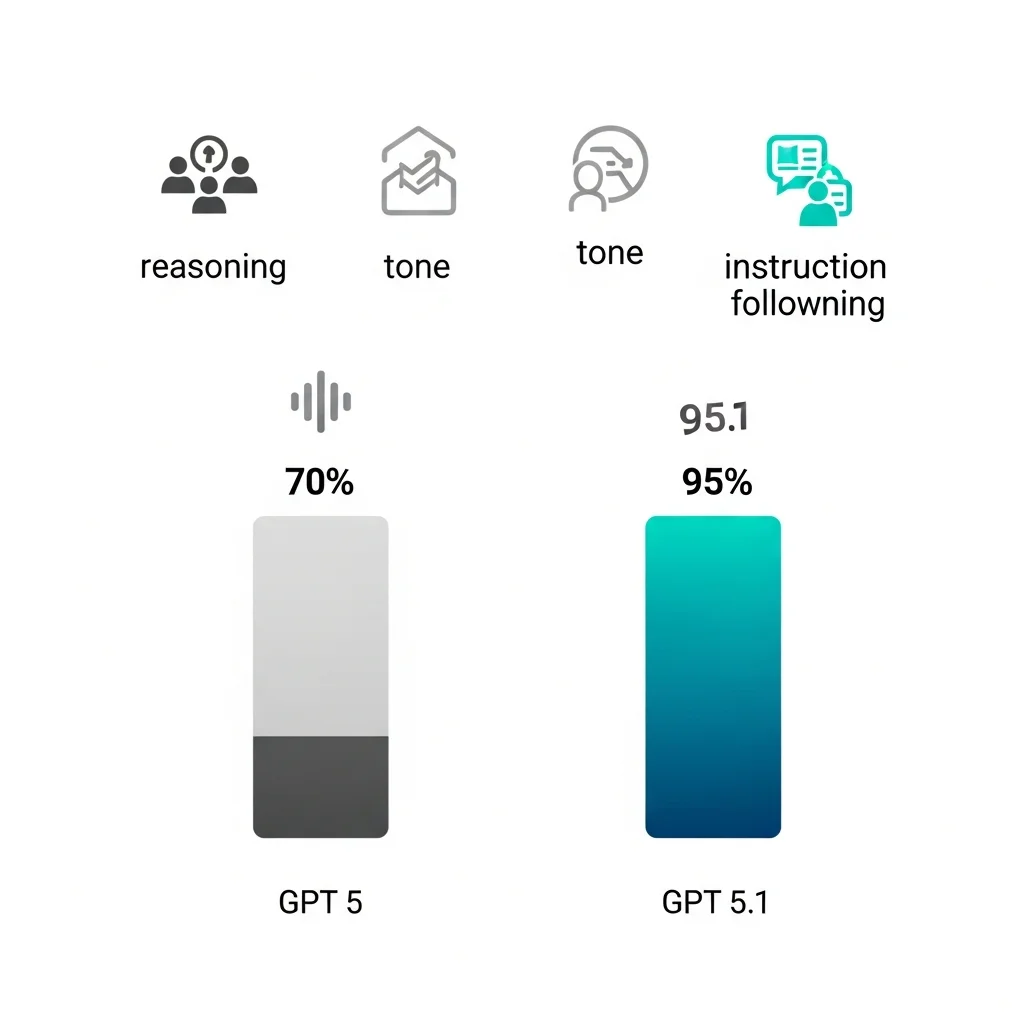GPT 5.1 has just rolled out and the first reactions range from surprised to stunned. Less robotic, smarter reasoning and far easier to steer in tone. In this blog I’ll walk you through the key improvements over GPT 5, what users are already noticing, and—above all—how SMEs can put this to work practically via the Spartner Mind AI platform.
From "smart chatbot" to "smart colleague": what exactly is GPT 5.1?
Imagine having a member of staff who instinctively knows when to fire back a quick answer and when to sit down and think deeply. That’s essentially what GPT 5.1 is trying to do.
OpenAI positions GPT 5.1 as the new flagship in the GPT 5 family. The same foundation of broad world knowledge, strong code generation and long context, but with a few fundamental upgrades. The big one: GPT 5.1 comes in two flavours—Instant and Thinking. Instant is for fast, everyday interactions, with low latency and a warmer, more conversational style. Thinking is designed for complex tasks such as multi-step planning, deep analysis or intricate code reviews, using adaptive reasoning to spend more thinking time on tough questions.
You can see this in OpenAI’s technical documentation with the adjustable reasoning level. Where GPT 5 in practice was often either slow and deep or fast but occasionally inconsistent, GPT 5.1 has an extra gear: a none- or low-reasoning mode for quick chats and a high-reasoning mode for serious brainwork. In practice that means the model judges for itself how much effort to put into your question. It sounds minor, but in daily use the difference feels huge.
Power users are already treating GPT 5.1 as a replacement for multiple models at once. Where you might have used GPT 4.1 for speed and a heavier reasoning model for tricky problems, GPT 5.1 can combine both roles. For SME owners that means less decision fatigue and more focus: a single model that adapts to the task instead of a zoo of models you have to swap between.
If you prefer a visual explanation, this video is well worth a look: GPT 5.1 Just Changed Everything Forever. The host demonstrates how Instant and Thinking behave in real workflows, from quick chat to in-depth code analysis.
GPT 5.1 versus GPT 5: where is the real quality gain?
Have you ever wondered why some AI answers are factually correct yet still feel artificial? The culprit is usually tone, nuance and how the model handles your instructions. That’s precisely where GPT 5.1 makes a big leap over GPT 5.
Early analyses and articles (including Notebookcheck and technical blogs on OpenAI’s new model guide) reveal three clear lines of improvement. First, reasoning: GPT 5.1 scores statistically higher in internal benchmarks for reasoning and coding tasks than GPT 5, thanks in part to an adaptive reasoning architecture. In Thinking mode the model deliberately spends more time on tough questions and makes fewer logical leaps. Users report fewer hallucinations on complex, multi-step problems and better explanations of how it reached an answer.
Second, tone and personality. OpenAI has introduced a much richer set of tone presets—Standard, Friendly, Efficient, Professional, Candid and Quirky. Notebookcheck describes this as a shift toward conversations that feel less robotic. In practice it means you can make GPT 5.1 speak like a down-to-earth consultant, an empathetic support agent or a ruthlessly efficient note-taker. Early experiences on X and Reddit show people especially value the consistency: the model sticks to the same style throughout the entire conversation instead of slipping back into generic marketing language halfway through.
Third, instruction following. A common complaint with GPT 5 was that it sometimes ignored specific demands: “write no more than 150 words”, “output JSON only”, or “don’t use bullet points”. GPT 5.1 is stricter here. According to the official guide, OpenAI invested explicitly in more reliable adherence to format and length instructions. We clearly notice that in our own content-generation tests. Ask GPT 5.1 for a summary in exactly three paragraphs with no lists and it sticks to it far better than GPT 5. Pro tip: combine this with clear tone presets and you suddenly have an AI that feels much more like an internal style guide than a standalone tool.
A subtle yet important quality difference is context retention. GPT 5.1 is better at keeping longer conversations and documents coherent. Especially in multi-turn scenarios such as “review this proposal, adjust it and then turn it into a client email” we see far less context loss between steps. In an SME environment, where people often switch back and forth between mail, documents and notes, that’s pure gold. It means less duplicate work and far fewer correction rounds. 🙂
What are users already noticing in real life?
I recently came across a discussion where developers and data scientists openly pitted GPT 5 against GPT 5.1 on their daily tasks. Interestingly, almost no-one started talking about even more tokens or even bigger context windows—they talked about how the model behaves as a conversation partner.
One recurring point is that GPT 5.1 feels warmer and less distant. That matches OpenAI’s own messaging, but it’s also what many users report in these first days: fewer generic disclaimers, more direct answers and a tone that feels more like a sharp colleague than a legal text. At the same time, people working with code say GPT 5.1 in Thinking mode is better at spotting subtle bugs and structuring larger refactors—not because it knows more than GPT 5, but because it reasons consciously, step by step.
Another striking experience is how GPT 5.1 handles complexity. Users note that the model is better at sensing when it needs to ask follow-up questions. Where GPT 5 would sometimes jump straight to a solution based on half the information, GPT 5.1 more often pauses and asks, “Would you like to tackle this via scenario A or B?” or “Which of these assumptions is correct in your situation?” It sounds small, but in consultancy-style contexts it saves a lot of misunderstandings and false assumptions.
What I notice in practice is that GPT 5.1 makes it easier to anchor AI in real processes. With GPT 5 you often saw teams using the model for isolated tasks: “write an email”, “produce a summary”, “generate a code snippet”. GPT 5.1 encourages continuous flows: from rough meeting notes to structured minutes to action points to outgoing emails— all in the same style and with consistent decisions. For SME organisations without an army of specialists, it suddenly feels like an extra, versatile colleague who keeps processes moving.
One last observation: the perception of reliability is shifting. After the rather lukewarm reception of GPT 5 many people were sceptical. GPT 5.1 is now seen mainly as a course correction toward user experience. The early community consensus seems to be that GPT 5.1 doesn’t introduce spectacular new magic, but it does the existing work far better. And that’s exactly what you need as a business owner: less friction, fewer surprises and more predictability in the output.
How SMEs can make smart use of GPT 5.1 through the Spartner Mind platform
So the key question for entrepreneurs isn’t “how smart is GPT 5.1?” but “how do I improve real-world processes without hassle?” That’s where the combination of GPT 5.1 with our own Mind AI platform comes in.
Mind is our AI middleware that brings all the major models together in one practical environment. Think GPT 5.1 and the other OpenAI models, but also alternatives such as Gemini, Grok, Claude and modern open-source models. For you as an SME the main benefit is that you don’t have to integrate or choose per model. Mind handles the connection, orchestration and security. You simply choose the behaviour you need: snappy Instant answers for web forms and chat, deep Thinking sessions for document analysis, compliance checks or complex quotes.
In concrete terms, I see a few powerful scenarios where GPT 5.1 in Mind is already making a difference. For marketing teams you can combine GPT 5.1 Thinking with our AI web page and blog automation. The model researches the top search results, understands search intent, then writes content in your own tone of voice. Thanks to better tone control that style stays consistent across landing pages, blogs and LinkedIn posts. From Mind we can publish that content straight into WordPress, Statamic or another CMS, complete with image suggestions and video ideas.
For more operational teams in HR, legal or finance, GPT 5.1 is a powerful engine in our document automation. Think meeting notes automatically turned into polished reports, contracts analysed for specific clauses, or ISO and compliance documents checked against your own policies. GPT 5.1’s better context retention and adaptive reasoning mean the model edits not just loose paragraphs but grasps the logic of the entire document. Mind links this directly to your existing storage, such as SharePoint or Google Drive, so new versions end up in the right place automatically.
And then there’s the customer side. In our bespoke AI chatbots and service-desk solutions we use GPT 5.1 to answer user questions not just accurately but in the right tone. A support bot, for instance, can be friendly and efficient with short answers and clear next steps, while an internal HR assistant can respond more empathetically with extra context and explanation. With GPT 5.1’s new tone presets and Mind’s data connections we can let those bots draw on your internal knowledge bases, CRM or ERP, while still keeping them safely within your corporate policies.
The beauty is that Mind doesn’t treat GPT 5.1 as an isolated “magic box” but as one of the building blocks in a larger architecture. We can use the same entry-level models for SEO automation, blog planning, social-media video scripts, service-desk emails and internal chatbots. Everywhere you benefit from the same improvements in reasoning, tone and instruction following. For an SME it feels like an integrated AI team that speaks your organisation’s language, rather than five separate tools each with its own user approach.

How does GPT 5.1 really differ from GPT 5 for an SME?
The biggest difference you’ll notice is behaviour, not just raw intelligence. GPT 5.1 has better tone control, follows instructions more tightly and can reason more or less deeply as needed. In our experience that means fewer edit rounds on text, better explanations of complex topics and an AI that fits more easily into your existing processes. 🙂
Isn’t GPT 5.1 just another hype entrepreneurs should be cautious about?
A healthy dose of caution is wise. What we’re seeing is that GPT 5.1 is less of a toy and more a quality update for serious use cases. The real win is stability and reliability. If you’re using AI for SEO, documents or customer contact it delivers a lot. If you just want to dabble with AI once, the model number is less important.
Do I need technical knowledge to use GPT 5.1 through Mind?
No—that’s exactly what our Mind platform is for. You define the processes and goals, we set up the underlying models, prompts and integrations. Of course, if you’re technically minded you can dive deeper into the settings, but you don’t have to. In practice we often work directly with marketers, HR, operations and management who never write a line of code.
Which applications deliver the fastest results for SMEs with GPT 5.1?
From our experience there are three main categories. One, marketing content: web pages, blogs and social posts that come out of the AI faster and more consistently. Two, document flows: quotes, reports, contracts and policy documents that are produced and checked more quickly. Three, customer service: email drafts and chatbots that handle queries faster and more personally—without having to rebuild your whole service organisation.
Can I combine GPT 5.1 with my own company data without exposing everything?
Yes, but only if you set it up correctly. In Mind we ensure models like GPT 5.1 can see your data during a query yet don’t use that data to train themselves publicly. We work with shielded connections to your CRM, ERP or document storage and log which queries are used for what. That gives you control over privacy, compliance and governance—essential in sectors like finance, legal and healthcare.
Is GPT 5.1 useful if my company mainly works physically, for example in construction or manufacturing?
Absolutely. What we see in practice is that construction, manufacturing and real estate gain hugely from better communication and documentation: quote proposals, technical descriptions, reports, checklists, emails to clients or partners. GPT 5.1 excels at that, especially when combined with domain-specific prompts and your own templates. It doesn’t have to be hyper-futuristic AI—often faster, better written work is already a huge step forward.
How does GPT 5.1 compare to other models that Mind supports?
GPT 5.1 is one of the strongest generalists, especially for language, reasoning and code. In Mind we often combine it with other models—for specialised image and video tasks, for instance, or when you need a different cost or speed profile. You don’t choose at model level; you choose the outcome you need. We handle the routing to GPT 5.1 Instant, Thinking or an alternative model behind the scenes.
What’s a good first step if I want to explore this in my organisation?
Start small but realistic. Pick one concrete flow, for example quotes and follow-up emails or blogs and news items for the website. Use GPT 5.1 via a platform like Mind to support that process from A to Z and measure what it does for time, quality and satisfaction. From that experience you can decide more precisely which next processes qualify. In our experience that works far better than trying to roll out AI everywhere at once. 🚀




